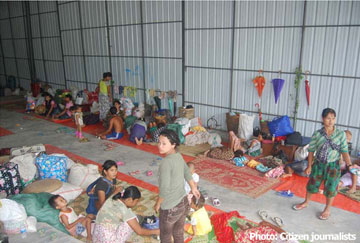While many humanitarian groups have called for more aid for Burmese refugees displaced by years of conflict, there is some optimism now that a series of cease-fire agreements may offer some hope to deliver badly needed food, medicine and shelter supplies.

A recent field report published by Refuges International (RI) focused on two key goals: allowing humanitarian groups freedom of access to refugee areas and the removal of elaborate donor restrictions.
The authors of the report, Lynn Yoshikawa and Kristen Cordell, assessed the humanitarian situation in November and December of last year.
There are an estimated 500,000 internally displaced people (IDPs) in Burma, and three million Burmese refugees in other countries, according to their study. There are also some 800,000 stateless Rohingyas in the west of the country, who live in dire humanitarian conditions because of their lack of basic human rights.
With the decrease in fighting now is the time for the humanitarian community – led by the UN Resident Coordinator/Humanitarian Coordinator (RC/HC) and supported by key donors like the European Union, United Kingdom, and United States – to expand operations in Burma, they wrote.
.
“Burma’s new government has demonstrated a willingness to work with the international community on humanitarian needs created by both natural disasters and conflict,” they said. “The government has finally recognized the existence of IDPs, and invited the UN to assess the displaced needs in Kachin State. In December, the government also took the unprecedented step of allowing UN agencies to assist IDPs in areas outside of its control.”
The newly formed government offers opportunities denied to the donor community.
“Previously, all approvals passed through both the military and ministries. Now the military has been removed from the process, and there are multiple decision-makers. Over the past year, the government has signed numerous Memorandums of Understanding (MoUs) with international non-governmental organizations (INGOs), some of which had been languishing in bureaucracy for years,” they said.
In addition, they said some government officials at the regional levels (such as the chief ministers of Kachin and Karen states) are now able to act independently of the central government, which has helped to expand access for international aid agencies assisting IDPs.
“While many of these efforts remain personality-driven, they illustrate the new entry points to engage authorities on humanitarian issues,” they wrote.
Over the past decade, they said, local NGOs in Burma have developed significantly and are now estimated to number in the hundreds. In Kachin State, church and monastery compounds are hosting thousands of IDPs organized by volunteer groups, with assistance provided by UN agencies.
The World Food Programme (WFP) and UNICEF have established offices throughout Burma’s border regions, yet the UN has failed to leverage its comparative advantages to strengthen the humanitarian dialogue with the Burmese government, they said.
“The recent arrival of the Office of the Coordination of Humanitarian Affairs (OCHA) in Burma and its growing dialogue with the government is an excellent opportunity for the incoming RC/HC to strengthen advocacy with the government to expand access to meet both immediate and long-term humanitarian needs, as well as request donors to increase humanitarian funding,” they wrote.
In recent years, the UK, EU, and Australia have significantly increased assistance inside Burma. However, the majority of the U.S. government’s $38.5 million contribution to Burma goes to organizations based in Thailand.
The research team said USAID’s Office of Foreign Disaster Assistance (OFDA) has spent only $100,000 in Burma since its response to Cyclone Nargis, despite widespread humanitarian needs resulting from conflict, natural disasters, and climate change.
Rolling back all U.S. sanctions may not be appropriate until key human rights benchmarks are met, they said, but removing specific barriers to technical assistance to key ministries and civil servants would allow Burma’s government to better respond to humanitarian needs and jumpstart the country’s stagnant development progress.
“While in Burma, RI met with aid workers who consistently spoke of civil servants operating at all levels of government without basic management, planning, and administrative skills,” they said. “One UN official said, ‘This government is like a newborn – it needs proper development and teaching.’”
Regional countries should also strengthen their engagement to build capacity of civil servants and lawmakers on public administration, policymaking, and program implementation, they said.
In the past year, local NGOs have significantly strengthened their advocacy with the government. One aid worker told RI, “NGOs here can fall into a trap if they do the government’s job without advocating and teaching [the government about] its obligations.”
For example, they said a local network of women’s organizations is helping government officials draft their implementation plan for the Convention on the Elimination of Discrimination Against Women. These steps will allow civil society to fully leverage new opportunities to influence the government, institute rights-based policies, and raise awareness of human rights, concluded the writers of the report.



